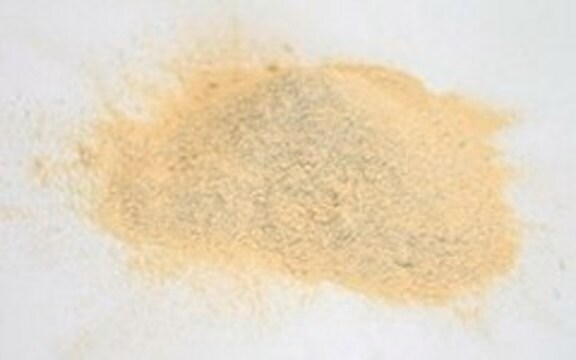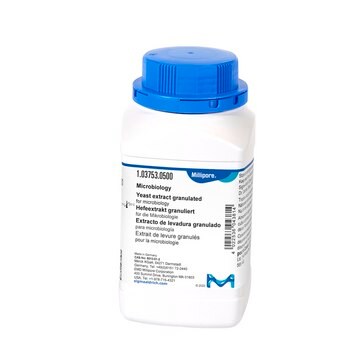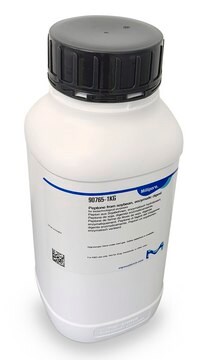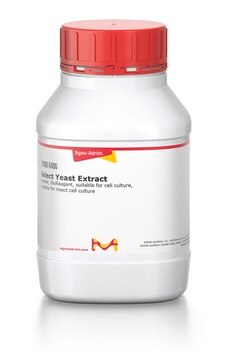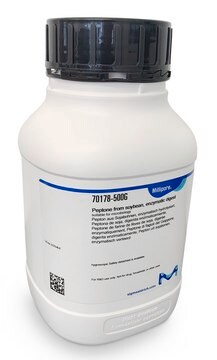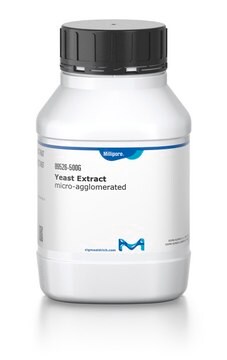70161
Yeast Extract
suitable for microbiology
Synonym(s):
YE, Baker’s yeast extract
Sign Into View Organizational & Contract Pricing
All Photos(2)
About This Item
CAS Number:
EC Number:
MDL number:
UNSPSC Code:
41106212
eCl@ss:
42040000
NACRES:
NA.74
Recommended Products
biological source
Saccharomyces cerevisiae
Quality Level
sterility
non-sterile
form
powder
composition
amino-nitrogen, ~5%
total nitrogen (N), ≥11%
ign. residue
≤15%
loss
≤6% loss on drying
pH
7.0±0.2 (2% in H2O)
solubility
H2O: 2%, clear, yellow
application(s)
environmental
food and beverages
microbiology
storage temp.
2-25°C
suitability
molds
yeasts
Looking for similar products? Visit Product Comparison Guide
General description
A water-soluble extract of autolyzed yeast cells, yeast extract is a mixture of amino acids, peptides, and water-soluble vitamins, for example, intact vitamin B12 complex and carbohydrates, and can be used as an additive for culture media and fermentation media. It can also be used in the resuscitation of a large variety of fastidious microorganisms.
Application
Yeast extract is recommended for use in culture media and the cultivation of various microorganisms. It provides multi-functional nutrient supplements that can also be used in microbial fermentation.
Storage Class Code
11 - Combustible Solids
WGK
WGK 1
Flash Point(F)
Not applicable
Flash Point(C)
Not applicable
Personal Protective Equipment
dust mask type N95 (US), Eyeshields, Gloves
Choose from one of the most recent versions:
Already Own This Product?
Find documentation for the products that you have recently purchased in the Document Library.
Customers Also Viewed
Alfredo Perales-Puchalt et al.
Journal of leukocyte biology, 103(5), 799-805 (2018-03-15)
Due to their cytotoxic activities, many anticancer drugs cause extensive damage to the intestinal mucosa and have antibiotic activities. Here, we show that cisplatin induces significant changes in the repertoire of intestinal commensal bacteria that exacerbate mucosal damage. Restoration of
Paul Vigne et al.
BMC physiology, 10, 8-8 (2010-05-15)
Recent attention has been given to the relationships between diet, longevity, aging and resistance to various forms of stress. Flies do not simply ingest calories. They sense different concentrations of carbohydrate and protein macronutrients and they modify their feeding behavior
Sara Hooshangi et al.
PLoS computational biology, 7(9), e1002172-e1002172 (2011-10-08)
Quorum sensing (QS) enables bacterial multicellularity and selective advantage for communicating populations. While genetic "switching" phenomena are a common feature, their mechanistic underpinnings have remained elusive. The interplay between circuit components and their regulation are intertwined and embedded. Observable phenotypes
Samriddha Ray et al.
The Journal of cell biology, 190(5), 793-805 (2010-09-02)
The mechanisms that regulate cytoskeletal remodeling during the transition between mitosis and interphase are poorly understood. In fission yeast the MOR pathway promotes actin polarization to cell tips in interphase, whereas the SIN signaling pathway drives actomyosin ring assembly and
Emilio M Ungerfeld et al.
Microorganisms, 7(5) (2019-05-01)
There is an interest in controlling rumen methanogenesis as an opportunity to both decrease the emissions of greenhouse gases and improve the energy efficiency of rumen fermentation. However, the effects of inhibiting rumen methanogenesis on fermentation are incompletely understood even
Our team of scientists has experience in all areas of research including Life Science, Material Science, Chemical Synthesis, Chromatography, Analytical and many others.
Contact Technical Service
